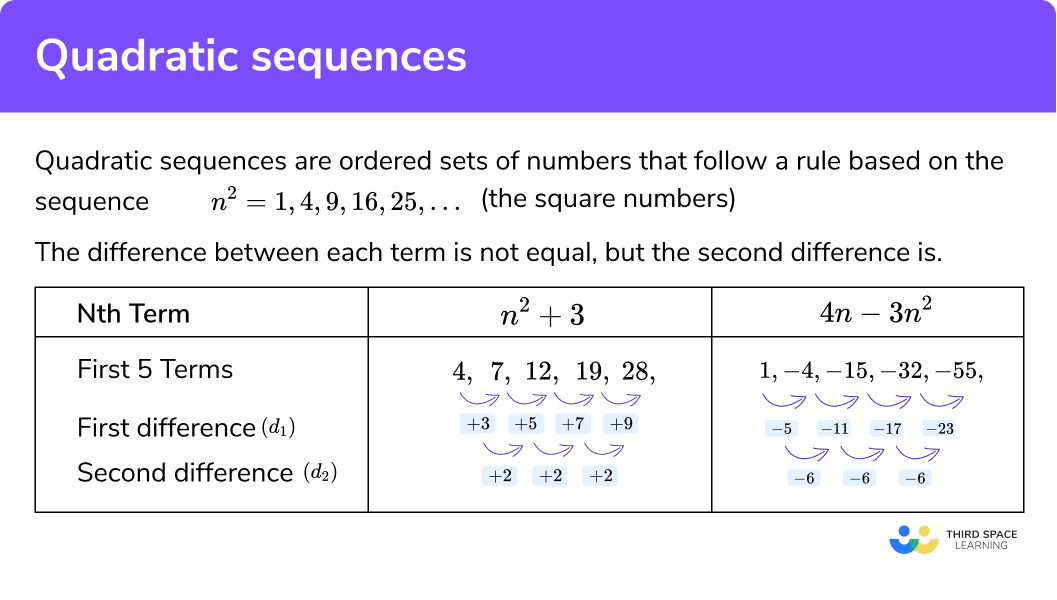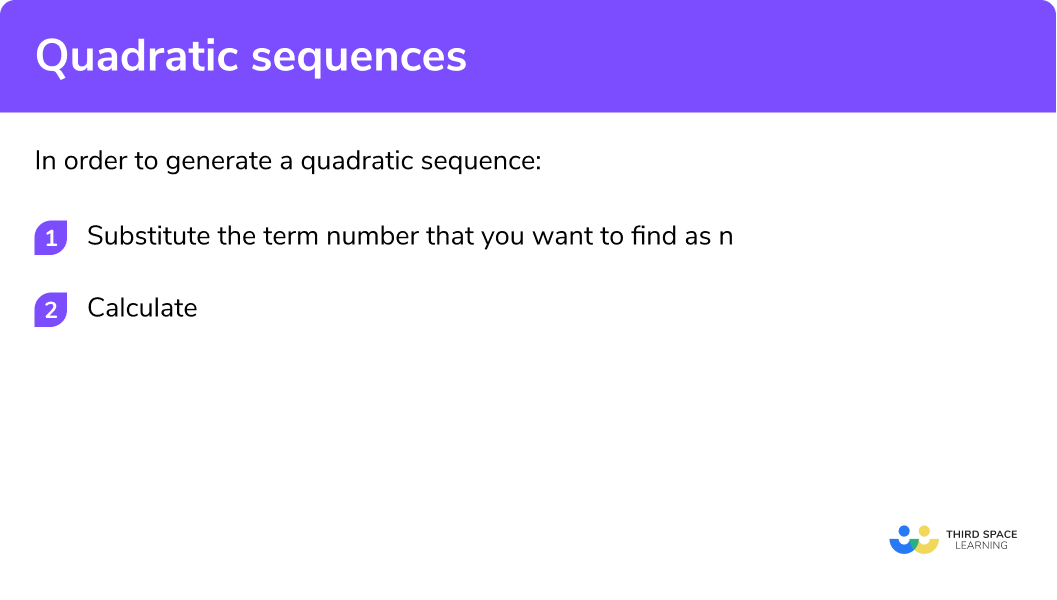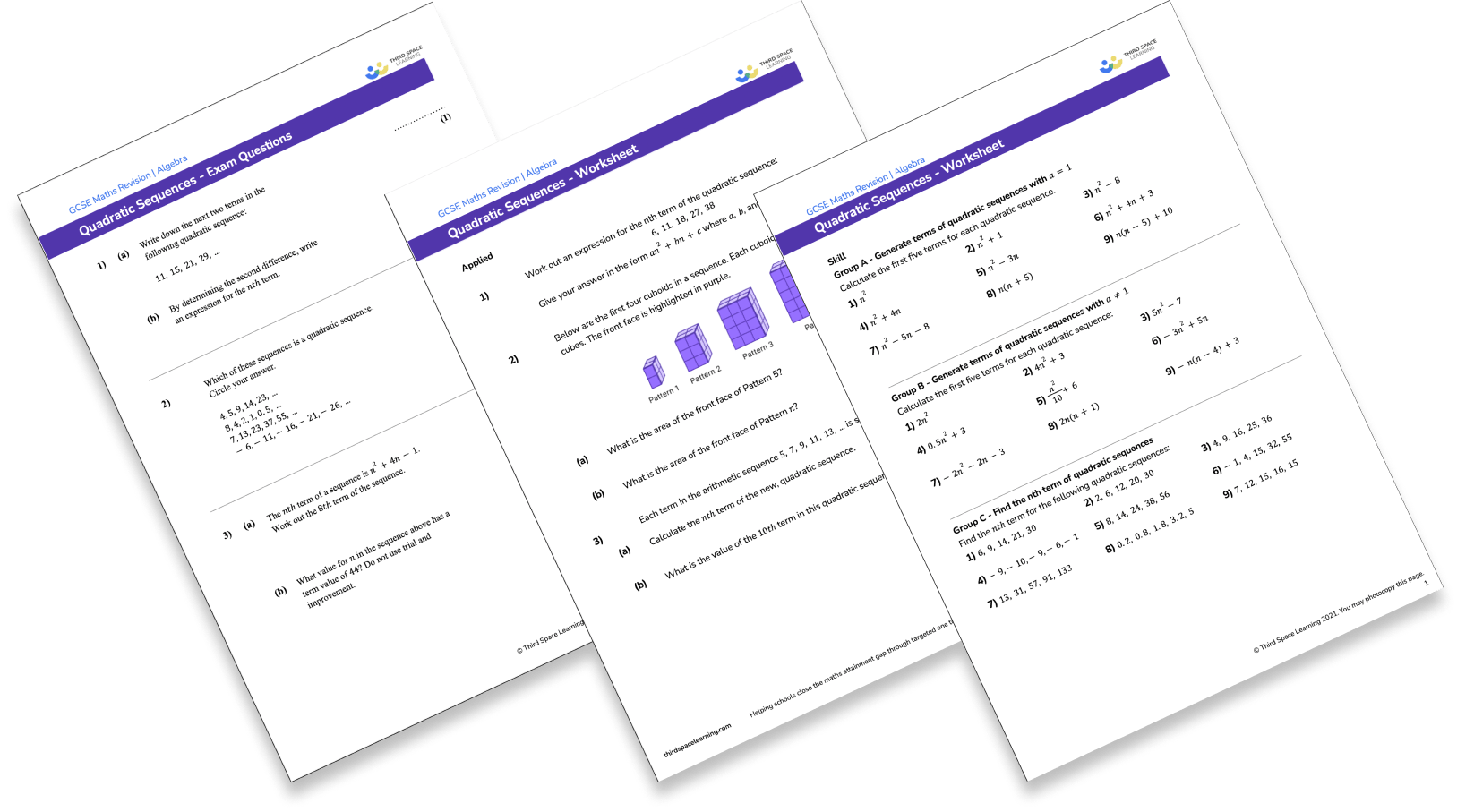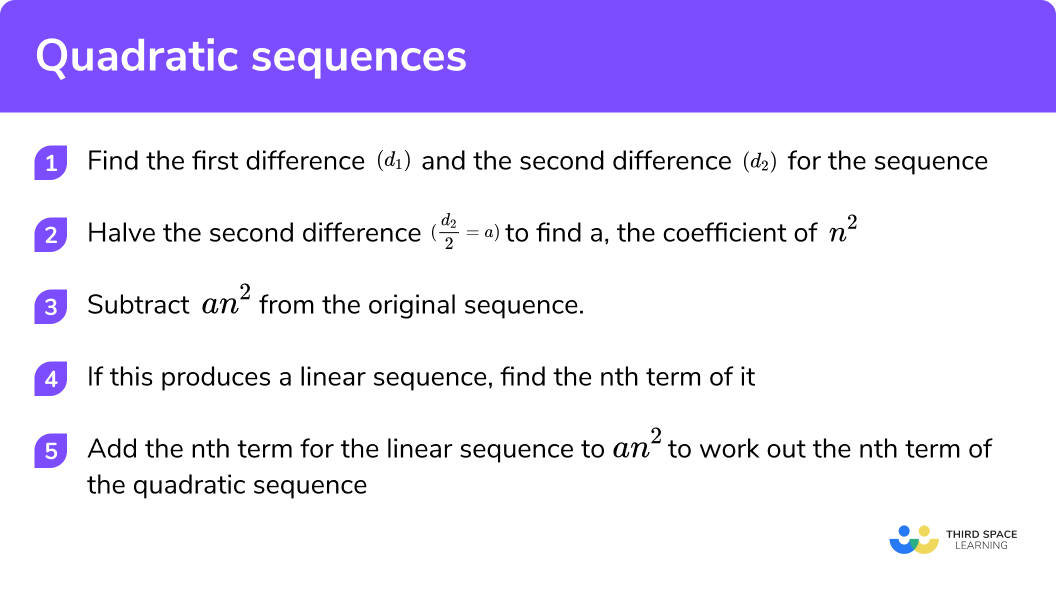GCSE Tutoring Programme
Our chosen students improved 1.19 of a grade on average - 0.45 more than those who didn't have the tutoring.
This topic is relevant for:

Quadratic Sequences
Here we will learn about quadratic sequences including how to recognise, use and find the nth term of a quadratic sequence.
There are also quadratic sequences worksheets based on Edexcel, AQA and OCR exam questions, along with further guidance on where to go next if you’re still stuck
Quadratic sequences are only studied on the higher GCSE Maths pathway.
What are quadratic sequences?
Quadratic sequences are ordered sets of numbers that follow a rule based on the sequence
Quadratic sequences always include an
The difference between each term in a quadratic sequence is not equal, but the second difference between each term in a quadratic sequence is equal.
Quadratic sequences can also be called quadratic algebraic sequences.
Here are two examples of quadratic sequences:
4, 7, 12, 19, 28 requires adding to work out that the second difference is +2
and
1, −4, −15, −32, −55 requires subtracting to work out that the second difference is −6
Example:
What are quadratic sequences?

How to generate terms of quadratic sequences
- Substitute the term number that you want to find as
n . - Calculate.
Explain how to generate quadratic sequences in 2 steps


Quadratic sequences worksheet

Get your free quadratic sequences worksheet of 20+ questions and answers. Includes reasoning and applied questions.
DOWNLOAD FREE
Quadratic sequences worksheet

Get your free quadratic sequences worksheet of 20+ questions and answers. Includes reasoning and applied questions.
DOWNLOAD FREERelated lessons on sequences
Quadratic sequences is part of our series of lessons to support revision on sequences. You may find it helpful to start with the main sequences lesson for a summary of what to expect, or use the step by step guides below for further detail on individual topics. Other lessons in this series include:
Quadratic sequence formula
The quadratic sequence formula is: an^{2}+bn+c
Where,
a, b and c are constants (numbers on their own)
n is the term position
We can use the quadratic sequence formula by looking at the general case below:
Let’s use this to work out the n^{th} term of the quadratic sequence,
4, 5, 8, 13, 20, ...First let’s find the first and second differences of the sequence:
Comparing this to the general case above, we can see that:
The second difference is equal to 2 so,
The first difference is equal to 1 so,
The first term is equal to 4 so,
We can see that a = 1,\; b = -2 and c = 5
So the nth of this quadratic sequence using the quadratic sequences formula is:
n^{2}-2n+5Generate terms of quadratic sequences examples
Example 1: finding terms of a sequence
Find the first three terms of the sequence with nth term
- Substitute the term number that you want to find as
n .
We want to find terms
First term:
Second term:
Third term:
2 Calculate.
Remember to apply BIDMAS
The first term is
Example 2: finding terms of a sequence
Find the tenth term of the sequence with
Substitute the term number that you want to find as n.
We want to find term
Calculate.
The tenth term is
How to find the n th term of quadratic sequences
In order to find the
1 Find the first difference
2 Halve the second difference
to find
3 Subtract
4 If this produces a linear sequence, find the
5 Add the nth term for the linear sequence to
What are the 5 steps to find the nth term of a sequence?

Step 4 is an additional step dependent on whether there is a remainder in step 3.
- If there is no remainder after subtracting
an2 from the original sequence, step 4 is not needed. - If the same constant remains for each term after the subtraction, we just add it to
an2 . - If a sequence is generated after step 3, continue with step 4.
See the table below.
| 1 | 2 | 3 | |
| Sequence | 2, 8, 18, 32, 50 | 3, 9, 19, 33, 51 | 5, 12, 23, 38, 57 |
| an2 | 2, 8, 18, 32, 50 | 2, 8, 18, 32, 50 | 2, 8, 18, 32, 50 |
| Step 3 | 0, 0, 0, 0, 0, … | 1, 1, 1, 1, 1, … | 3, 4, 5, 6, 7, … |
| Step 4 | n + 2 | ||
| Step 5 | 2n2 | 2n2 + 1 | 2n2 + 1 + 2 |
Here,
- Sequence 1 had no remainder and so the sequence is
2n2 - Sequence 2 had a remainder of 1 and so this sequence is
2n2 + 1 - Sequence 3 had another sequence as the remainder and so the nth term of this linear sequence was calculated and added to
2n2 to get2n2 + n + 2.
Find the n th term of quadratic sequences examples
Example 3: find the n th term of a quadratic sequence of the form an2 .
Find the
Find the first difference (d_{1}) and second difference (d_{2}) for the sequence.
Here, the second difference
Halve the second difference
to find
This means
Subtract an^{2} from the original sequence.
| Original Sequence | 2 | 8 | 18 | 32 | 50 |
| n2 | 1 | 4 | 9 | 16 | 25 |
| 2n2 | 2 | 8 | 18 | 32 | 50 |
| OS − 2n2 | 0 | 0 | 0 | 0 | 0 |
Here, the remainder for each term is
Find the nth term for the linear sequence generated.
Not required for this example as the remainder is
Add the nth term for the linear sequence to an^{2} to find the nth term of the quadratic sequence.
The nth term of the quadratic sequence is
Example 4: find the n th term of a quadratic sequence of the form an2 + c .
Find the
Find the first difference (d_{1}) and second difference (d_{2}) for the sequence.
Here, the second difference
Halve the second difference.
to find
This means
Subtract an^{2} from the original sequence.
| Original Sequence | 5 | 14 | 29 | 50 | 77 |
| n2 | 1 | 4 | 9 | 16 | 25 |
| 3n2 | 3 | 12 | 27 | 48 | 75 |
| OS − 3n2 | 2 | 2 | 2 | 2 | 2 |
Here, the remainder for each term is
Find the nth term for the linear sequence generated.
Not required for this example as the remainder is
Add the nth term for the linear sequence to an^{2} to find the nth term of the quadratic sequence.
The nth term of the quadratic sequence is
Example 5: find the nth term of a quadratic sequence of the form an2 + bn + c .
Find the nth term of this quadratic sequence:
Find the first difference (d_{1}) and second difference (d_{2}) for the sequence
Here, the second difference
Halve the second difference
to find
This means
Subtract an^{2} from the original sequence.
| Original Sequence | 9 | 18 | 31 | 48 | 69 |
| n2 | 1 | 4 | 9 | 16 | 25 |
| 2n2 | 2 | 8 | 18 | 32 | 50 |
| OS − 2n2 | 7 | 10 | 13 | 16 | 19 |
Here, the remainder generates a linear sequence and so we must find the
Find the nth term for the linear sequence generated.
Here, the nth term for the remainder is
Add the nth term for the linear sequence to an^{2} to find the nth term of the quadratic sequence.
Here, the nth term of the quadratic sequence is
Example 6: find the n th term of a quadratic sequence of the form an2 + bn + c .
Find the nth term of this quadratic sequence:
Find the first difference (d_{1}) and second difference (d_{2}) for the sequence.
Here, the second difference
Halve the second difference.
to find
This means
Subtract an^{2} from the original sequence.
| Original Sequence | 19 | 36 | 61 | 94 | 135 |
| n2 | 1 | 4 | 9 | 16 | 25 |
| 4n2 | 4 | 16 | 36 | 64 | 100 |
| OS − 4n2 | 15 | 20 | 25 | 30 | 35 |
Here, the remainder generates a linear sequence and so we must find the
Find the nth term for the linear sequence generated.
Here, the nth term for the remainder is
Add the nth term for the linear sequence to an^{2} to find the nth term of the quadratic sequence.
Here, the
Example 7: find the n th term of a quadratic sequence of the form an2 + bn + c where terms are generated using a pattern.
In the diagram below, the area of each pool can be represented by a quadratic sequence.
Find the area for a pool of width
Find the first difference (d_{1}) and second difference (d_{2}) for the sequence.
Here, the second difference
Halve the second difference.
to find
This means
Subtract an^{2} from the original sequence.
| Original Sequence | 1 | 4 | 9 | 16 | 25 |
| n2 | 1 | 4 | 9 | 16 | 25 |
| OS − n2 | 0 | 0 | 0 | 0 | 0 |
Here, the remainder for each term is
Find the nth term for the linear sequence generated.
Not required for this example as the remainder is
Add the nth term for the linear sequence to an^{2} to find the nth term of the quadratic sequence.
The
So the area of the pool with width
Example 8: find the n th term of a quadratic sequence of the form an2 + bn + c where a < 0 .
Find the nth term of this quadratic sequence:
Find the first difference (d_{1}) and second difference (d_{2}) for the sequence.
Here, the second difference
Halve the second difference.
to find
This means
Subtract an^{2} from the original sequence.
| Original Sequence | 8 | -10 | -34 | -64 | -100 |
| n2 | 1 | 4 | 9 | 16 | 25 |
| −3n2 | -3 | -12 | -27 | -48 | -75 |
| OS − (−3n2 ) | 11 | 2 | -7 | -16 | -25 |
Here, the remainder generates a linear sequence and so we must find the
Find the nth term for the linear sequence generated.
Add the nth term for the linear sequence to an^{2} to find the nth term of the quadratic sequence.
Here, the
Common misconceptions
- The value of the second difference is not halved before using it as the coefficient of
n2
For example, for the quadratic sequence
- The quadratic sequence is answered as if it were an arithmetic sequence
For a quadratic sequence we will have a common second difference.
- When the sequence is decreasing into negative terms, the second difference is written incorrectly as a positive number
For example, the sequence
- The remainder is subtracted from the
an2 term rather than added as it was found by subtraction
For example, the remainder for the sequence
- The value for
n cannot be negative
This is important when finding the term in the sequence given its value as a zero or negative solution for
- The value for the term is used instead of
n
For example, find
Practice quadratic sequences questions
1. Work out the first five terms of the sequence 2n^2-7n




2. Find the nth term of the quadratic sequence:
-2, 1, 6, 13, 22




The second difference is 2
2 \div 2 = 1
Therefore it is n^{2}
\begin{aligned} &Original \; Sequence \quad \quad -2 \quad \quad 1 \quad \quad 6 \quad \quad 13 \quad \quad 22\\ &n^2 \hspace{3.7cm} 1 \quad \quad 4 \quad \quad 9 \quad \quad 16 \quad \quad 25\\ &OS-n^2 \hspace{2.5cm} -3 \quad -3 \quad -3 \quad \;-3 \quad \;\;-3 \end{aligned}
The remainder is 3 for each term therefore our sequence is
n^{2}-3
3. The first five terms of a quadratic sequence are 0, 13, 34, 63 and 100 . By calculating the second difference, find the nth term of the sequence.




The second difference is 8.
8 \div 2 = 4
Therefore it is 4n^{2}
\begin{aligned} &Original \; Sequence \quad \quad 0 \quad \quad 13 \quad \quad 34 \quad \quad 63 \quad \quad 100\\ &n^2 \hspace{3.2cm} \;1 \quad \quad\; 4 \quad \quad \;\;9 \quad \quad 16 \quad \quad\; \;25\\ &4n^2 \hspace{3.1cm} 4 \quad \quad 16 \quad \quad 36 \quad \quad 64 \quad \quad 100\\ &OS-n^2 \hspace{2cm}\; -4 \quad \;-3 \quad \;\; -2 \quad \;\;-1 \quad \quad \;\;0 \end{aligned}
The nth term of -4, -3,-2, -1, 0, … is n-5 so our sequence is
4n^{2}+n-5
4. Find the nth term of the decimal quadratic sequence:
2.1, 4.4, 6.9, 8.6, 10.5




The second difference is 0.2
0.2 \div 2 = 0.1
Therefore it is 0.1n^{2}
\begin{aligned} &Original \; Sequence \quad \quad 2.1 \quad \quad 4.4 \quad \quad 6.9 \quad \quad 8.6 \quad \quad 10.5\\ &n^2 \hspace{3.4cm} 1 \quad \quad\; \;\;4 \quad \quad \;\;\;9 \quad \quad \;16 \quad \quad\; \;25\\ &0.1n^2 \hspace{2.9cm} 0.1 \quad \quad 0.4 \quad \quad 0.9 \quad \;\;\;1.6 \quad \quad \;2.5\\ &OS-0.1n^2 \hspace{2.1cm} 2 \quad\quad\;\; \;4 \quad \quad \;\;\;6 \quad \quad \;\; 8 \quad \quad \;\;\;10 \end{aligned}
The nth term of 2, 4, 6, 8, 10 is 2n so our sequence is
0.1n^{2} +2n
5. Below are the first four terms of a patterned sequence. Calculate the formula to work out the number of tiles in pattern n.




Number of tiles: 5, 8, 13, 20
The second difference is 2
2 \div 2 = 1
Therefore it is n^{2}
\begin{aligned} &Original \; Sequence \quad \quad 5 \quad \quad 8 \quad \quad 13 \quad \quad 20 \quad \quad 29\\ &n^2 \hspace{3.2cm} \;1 \quad \quad 4 \quad \quad \;9 \quad \;\quad 16 \quad \quad 25\\ &OS-n^2 \hspace{2.4cm} 4 \quad \quad 4 \quad \quad \; 4 \quad \quad \;\;4 \quad \quad \;\;4 \end{aligned}
The remainder is 4 each time so the nth term is
n^{2}+4
6. The first five terms of a quadratic sequence are 5, 2, -3, -10, and -19 . The formula for the nth term of this sequence can be written in the form a+bn^{2} where a and b are integers. Find the values of a and b .




The second difference is -2
-2 \div 2 = -1
Therefore it is -n^{2}
\begin{aligned} &Original \; Sequence \quad \quad 5 \quad \quad 2 \quad \; -3 \quad \; -10 \quad \; -19\\ &-n^2 \hspace{2.5cm} \;-1 \quad -4 \quad \; -9 \quad \;-16 \quad \; -25\\ &OS-n^2 \hspace{2.4cm} 6 \quad \quad 6 \quad \quad \; 6 \quad \quad \;\;6 \quad \quad \;\;6 \end{aligned}
The nth term is -n^2+6, which can also be written as 6-n^2.
a=6 and b=-1.
Quadratic sequences GCSE questions
1. Work out the first four terms in the sequence with n th term 2n^{2} + 5n – 3
(2 marks)
= 4, 15, 30, 49
(2)
2.
(a) Here is a patterned sequence made from equilateral triangles.
Find the n th term formula for the number of triangles used to form each pattern.
(b) How many triangles would be used in the 20th pattern?
(6 marks)
(a)
Sequence is 1, 3, 6, 10
First differences: 2, 3, 4
Second differences: 1, 1
(1)
0.5n^{2}
(1)
| Original Sequence | 1 | 3 | 6 | 10 |
| n2 | 1 | 4 | 9 | 16 |
| 0.5n2 | 0.5 | 2 | 4.5 | 8 |
| OS − (0.5n2 ) | 0.5 | 1 | 1.5 | 2 |
(1)
N th term of 0.5, 1, 1.5, 2 is 0.5n so formula is
0.5n^{2} + 0.5n
(1)
(b)
0.5 \times 20^{2} + 0.5 \times 20
(1)
210
(1)
3. The first four terms in a sequence are:
12, 20, 30, 42, 56
(a) Find the n th term formula for this sequence.
(b) Hence find which term has value 110 .
(7 marks)
(a)
First differences: 8, 10, 12, 14
Second differences: 2, 2, 2
(1)
n^{2}
(1)
| Original Sequence | 12 | 20 | 30 | 42 | 56 |
| n2 | 1 | 4 | 9 | 16 | 25 |
| OS-0n2 | 11 | 16 | 21 | 26 | 31 |
(1)
N th term of 11, 16, 21, 26, 31 is 5n+6 so formula is
n^{2}+5n+6
(1)
(b)
n^{2}+5n+6=110
(1)
\begin{aligned} n^{2}+5n-104&=0 \\ (n-8)(n+13)&=0 \end{aligned}
(1)
n = 8, 8th term
(cannot have -13th term)
(1)
Learning checklist
You have now learned how to:
-
recognise and use quadratic sequences
-
deduce expressions to calculate the nth term of quadratic sequences.
The next lessons are
Still stuck?
Prepare your KS4 students for maths GCSEs success with Third Space Learning. Weekly online one to one GCSE maths revision lessons delivered by expert maths tutors.

Find out more about our GCSE maths tuition programme.